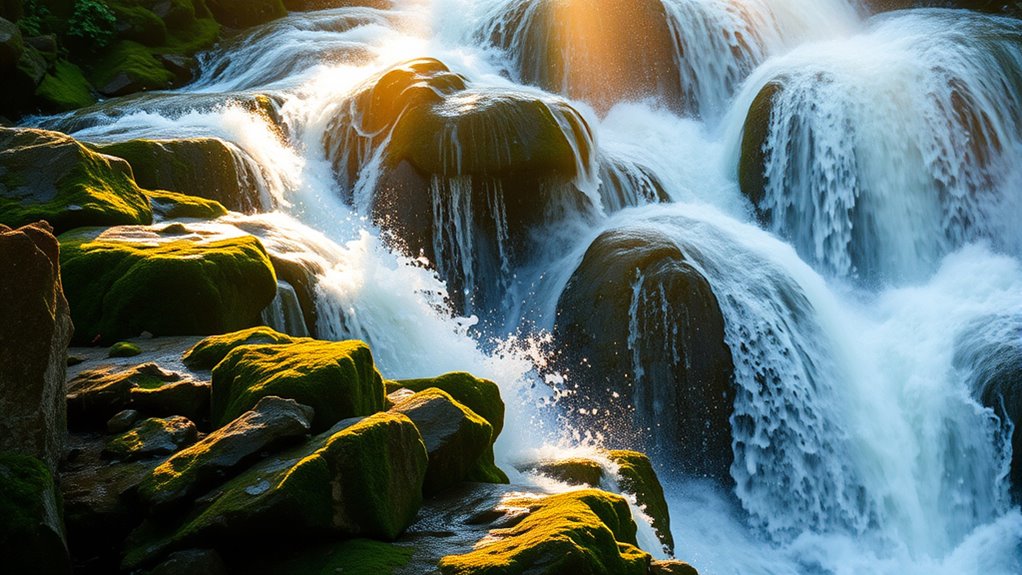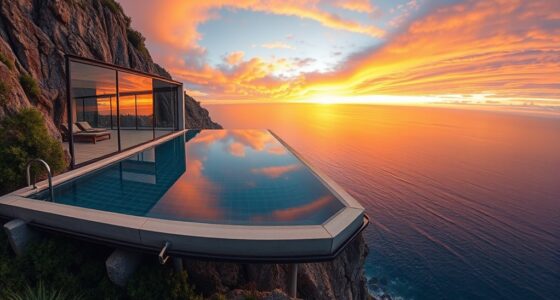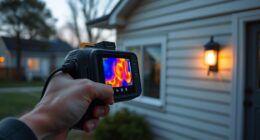To tune waterfall soundscapes for calm or drama, focus on adjusting key elements like volume, pitch, and layering of sounds. For calmness, soften high-frequency splashes and emphasize gentle, low-frequency flows while minimizing abrupt changes. To create drama, highlight louder splashes, variable volumes, and add background elements like thunder or wind. Using quality sound equipment and digital controls helps refine these effects. Keep exploring further techniques to master the perfect atmosphere for your space.
Key Takeaways
- Adjust high-frequency sounds to soften sharp splashes for a calming, smooth waterfall experience.
- Emphasize low-frequency flows and gentle volume levels to evoke tranquility and stability.
- Layer sounds with dynamic variations, shifting between gentle and powerful moments for drama or calm.
- Incorporate background elements like distant wind or thunder to enhance mood and atmosphere.
- Use digital tools to precisely control sound layers, pitch, and volume for tailored calm or dramatic effects.
Understanding Waterfall Sound Characteristics
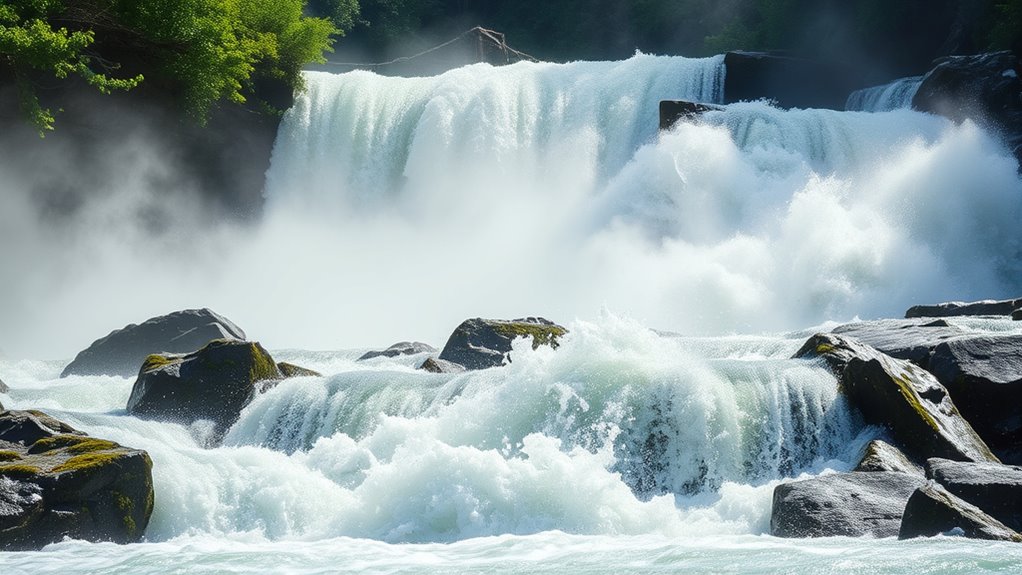
Waterfall sounds are defined by their dynamic and complex acoustic properties, which can evoke a range of emotional responses. You notice the varying intensities of rushing water, from gentle trickles to thunderous cascades. The sound contains a rich mix of low-frequency rumbles and high-frequency splashes, creating a layered auditory experience. As you listen, you might feel calm from the steady, soothing flow or energized by the power and unpredictability of the water. The pitch and volume fluctuate naturally, influenced by the waterfall’s height, volume, and surrounding environment. These characteristics shape how you perceive the sound—whether as peaceful or dramatic. Understanding these fundamental properties helps you appreciate how water soundscapes can be tuned to influence your mood or setting intentionally.
Techniques for Enhancing Calmness in Waterfall Noises
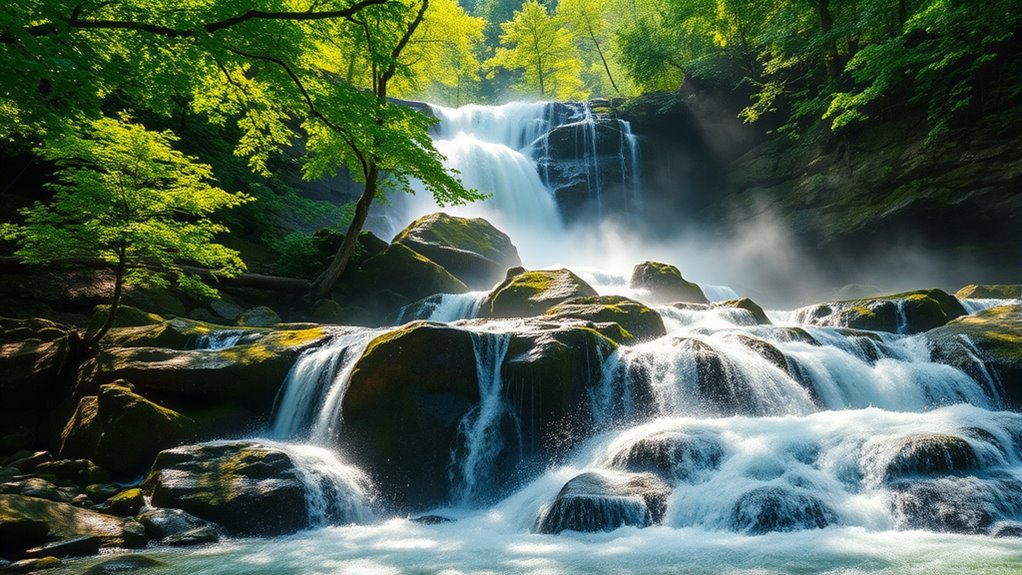
To foster a sense of calmness in water soundscapes, you can intentionally modify the acoustic qualities of waterfall noises. First, soften high-frequency sounds to reduce sharpness, creating a smoother, more soothing experience. Second, increase the prominence of gentle, low-frequency flows that evoke stability and tranquility. Third, reduce abrupt changes or sudden peaks in volume to maintain a consistent, calming rhythm. Fourth, incorporate subtle background sounds like distant wind or soft rustling to add depth and serenity. Fifth, selecting soundscapes with high-quality HEPA filtration can further improve the environment by removing airborne irritants, enhancing overall relaxation. By adjusting these elements, you shape the soundscape into a calming environment, helping your mind relax and focus. These techniques allow you to craft waterfalls that soothe, promote mindfulness, or provide peaceful background noise.
Crafting Dramatic and Energizing Waterfall Atmospheres
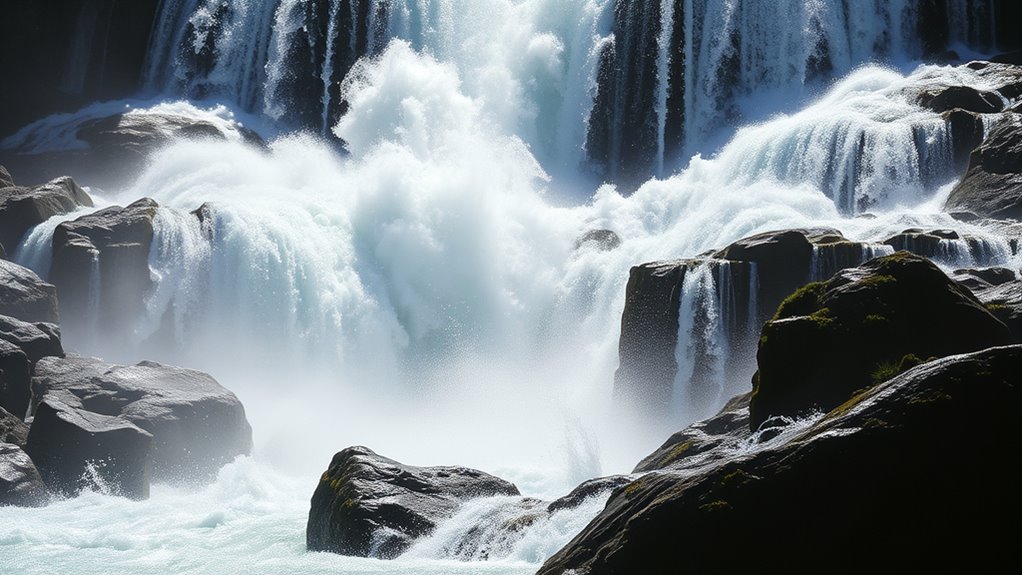
When you want to create a dramatic and energizing waterfall soundscape, focus on emphasizing the waterfall’s power and dynamic range. Use recordings that capture the full force of the water, including sudden splashes and roaring flows, to evoke excitement and intensity. Incorporate variations in volume and pitch to highlight the waterfall’s movement, making it feel alive and powerful. Layer sounds with occasional bursts of speed or louder cascades to build momentum. Adding subtle background elements, like distant thunder or wind, can amplify the drama. Keep the pacing dynamic, shifting between calm moments and explosive sections. This contrast heightens the sense of energy, immersing you in a vibrant, invigorating environment that energizes your mood or enhances a dramatic scene. Incorporating personalized care principles can help tailor sound environments to individual needs, ensuring a more comfortable and engaging experience.
The Role of Sound Equipment and Digital Tools

Choosing the right sound equipment and digital tools can substantially shape the effectiveness of your waterfall soundscape. High-quality speakers or headphones ensure clear, immersive audio, while digital software allows precise control over sound layers. To optimize your setup, consider these key aspects:
Selecting quality sound equipment and digital tools enhances your waterfall soundscape’s clarity and depth.
- Sound Source Quality: Use recordings or synthesizers with high fidelity to capture realistic waterfall sounds.
- Equalization Settings: Adjust frequencies to emphasize calmness or drama, tailoring the mood.
- Looping and Mixing: Seamlessly blend multiple water sounds for depth and complexity.
- Volume Control: Maintain consistent levels to prevent distractions or discomfort.
- Environmental Impact: Selecting eco-friendly sound equipment can minimize your environmental footprint and promote sustainable practices.
Practical Applications and Benefits of Waterfall Soundscapes
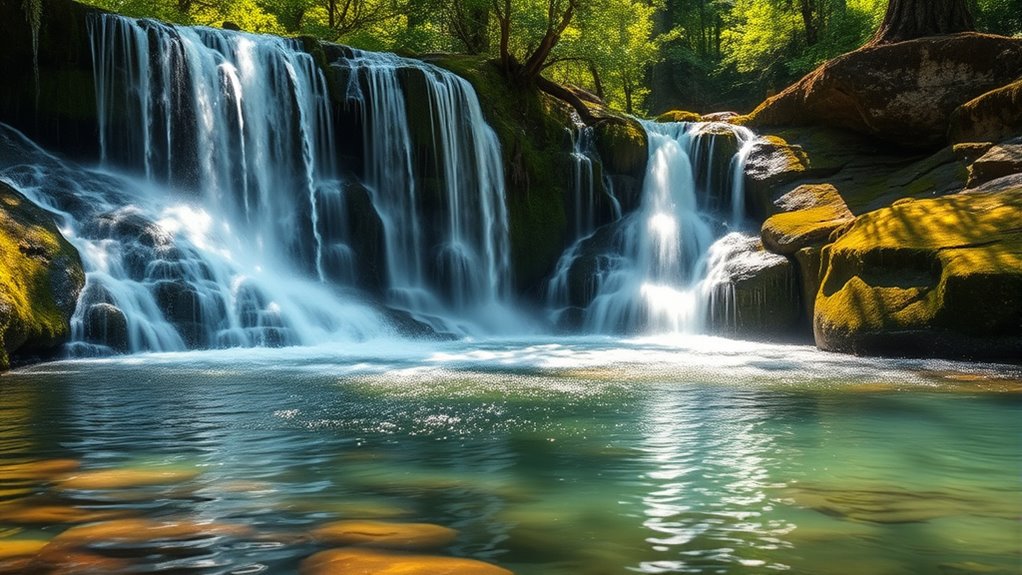
Waterfall soundscapes offer versatile benefits across various settings, enhancing both wellbeing and productivity. If you include waterfall sounds in your workspace, you may find it easier to focus, as the consistent noise can mask distracting sounds and create a calming atmosphere. In relaxation areas, these soundscapes promote stress reduction and mental clarity, helping you unwind after a busy day. They also serve as effective background noise in therapy or meditation spaces, deepening relaxation and mindfulness. Additionally, incorporating waterfall sounds into sleep environments can improve sleep quality by soothing restless minds. Whether used in offices, homes, or wellness centers, waterfall soundscapes provide a simple, cost-effective way to create an environment that fosters calm, enhances concentration, and supports overall mental health. Understanding soundscape benefits can further help you tailor these environments to your needs.
Frequently Asked Questions
How Do Natural Environments Influence Waterfall Soundscapes?
Natural environments shape waterfall soundscapes by surrounding you with diverse elements like trees, rocks, and wildlife that modify the sound. Dense forests absorb some noise, creating a calmer atmosphere, while open landscapes amplify the roar, adding drama. The terrain and vegetation influence the water’s flow and echo, helping you feel immersed or energized. By understanding these factors, you can tune your environment to promote calm or excitement effectively.
Can Waterfall Sounds Be Personalized for Individual Preferences?
You can definitely personalize waterfall sounds to match your preferences. Many apps and devices let you adjust volume, add effects like rain or wind, or even mix multiple water sounds together. Imagine turning a gentle stream into a thunderous cascade or calming trickle—it’s all at your fingertips. By customizing these soundscapes, you create a unique auditory environment that enhances relaxation or energizes you, perfectly suited to your mood and needs.
What Are the Best Settings for Portable Sound Devices?
You should set your portable sound device to a comfortable volume that blocks out background noise without causing discomfort. Use high-quality earphones or speakers for clarity. Adjust the tone and pitch to match your preference—more mellow for relaxation or more dynamic for alertness. Experiment with the white noise, nature sounds, or waterfall settings, and tweak bass or treble controls until you find a soothing or energizing balance that feels right.
How Do Waterfall Soundscapes Impact Sleep Quality?
Waterfall soundscapes can profoundly improve your sleep quality by creating a calming environment that masks disruptive noises. The consistent, soothing sound helps lower your stress levels and promotes relaxation, making it easier to fall asleep and stay asleep longer. By tuning the waterfall noise to a gentle, steady level, you can enhance your sleep experience, reduce anxiety, and wake up feeling more refreshed and rested.
Are There Cultural Differences in How Waterfalls Are Perceived?
You might think everyone sees waterfalls the same way, but surprisingly, cultural differences shape perceptions profoundly. While some view waterfalls as symbols of tranquility and spiritual renewal, others see them as powerful, chaotic forces. You could find serenity in a gentle cascade or feel awe at a roaring torrent. Your cultural background influences whether you find calm or drama in water’s relentless descent, revealing how perceptions are shaped by tradition and experience.
Conclusion
Now that you understand how to tune waterfall sounds for calm or drama, you can create the perfect atmosphere for any moment. Whether you want peaceful serenity or a lively, energizing vibe, adjusting sound characteristics and using the right tools makes all the difference. Remember, even in this digital age, a well-crafted soundscape can transport you to a tranquil forest or a roaring waterfall faster than you can say “Eureka!” So go ahead, craft your ideal sound environment.
